Retroactive Ordering for Dynamic Backtracking
《2024年融合因果注意力Transformer模型的股价预测研究》范文

《融合因果注意力Transformer模型的股价预测研究》篇一一、引言随着金融市场的日益复杂化,股价预测成为了投资者和金融机构关注的焦点。
传统的股价预测方法多基于统计模型或机器学习方法,然而,这些方法在处理时间序列数据时往往难以捕捉到长期依赖关系和未来信息。
近年来,深度学习技术的发展为股价预测提供了新的思路。
其中,Transformer模型因其强大的自注意力机制在自然语言处理等领域取得了显著成果。
本文旨在研究融合因果注意力的Transformer模型在股价预测中的应用,以期提高预测的准确性和实时性。
二、相关研究背景Transformer模型由Google于2017年提出,其自注意力机制能够有效地捕捉序列中的依赖关系。
然而,在股价预测中,我们不仅需要关注当前时刻的上下文信息,还需要考虑时间序列的因果关系。
因此,融合因果注意力的Transformer模型成为了研究的热点。
该模型在Transformer的基础上引入了因果注意力机制,使模型能够更好地处理具有时间顺序性的数据,如股价等金融时间序列数据。
三、模型与方法(一)融合因果注意力Transformer模型构建本文所提出的融合因果注意力Transformer模型包括两个主要部分:自注意力机制和因果注意力机制。
自注意力机制用于捕捉序列中的依赖关系,而因果注意力机制则用于确保模型在处理时间序列数据时能够遵循因果关系。
(二)数据预处理与特征提取在进行模型训练之前,需要对股价数据进行预处理和特征提取。
首先,对原始股价数据进行清洗和归一化处理,然后提取出时间序列特征、技术指标等。
这些特征将被输入到模型中进行训练。
(三)模型训练与优化采用深度学习框架(如TensorFlow或PyTorch)实现模型的训练和优化。
通过设置合适的损失函数和优化器,使模型能够自动学习到股价数据中的因果关系和依赖关系。
同时,采用早停法等策略防止过拟合,提高模型的泛化能力。
四、实验与结果分析(一)实验设置为了验证模型的性能,我们选择了多个股票进行实验。
Computers & Electrical Engineering样文

Adaptive control of dynamic mobile robots withnonholonomic constraintsFarzad Pourboghrat *,Mattias P.KarlssonDepartment of Electrical and Computer Engineering,Southern Illinois University,Carbondale,IL 62901-6603,USAReceived 16November 1999;accepted 22August 2000AbstractThis paper presents adaptive control rules,at the dynamics level,for the nonholonomic mobile robots with unknown dynamic parameters.Adaptive controls are derived for mobile robots,using backstepping technique,for tracking of a reference trajectory and stabilization to a fixed posture.For the tracking problem,the controller guarantees the asymptotic convergence of the tracking error to zero.For stabili-zation,the problem is converted to an equivalent tracking problem,using a time varying error feedback,before the tracking control is applied.The designed controller ensures the asymptotic zeroing of the sta-bilization error.The proposed control laws include a velocity/acceleration limiter that prevents the robot Õs wheels from slipping.Ó2002Elsevier Science Ltd.All rights reserved.Keywords:Mobile robot;Nonholonomic constraint;Dynamics level motion control;Stabilization and tracking;Adaptive control;Backstepping technique;Asymptotic stability1.IntroductionMotion control of mobile robots has found considerable attention over the past few years.Most of these reports have focused on the steering or trajectory generation problem at the ki-nematics level i.e.,considering the system velocities as control inputs and ignoring the mechanical system dynamics [1–3].Very few reports have been published on control design in the presence of uncertainties in the dynamic model [4].Some preliminary results on control of nonholonomic systems with uncertainties are given in Refs.[4–6].Two of the most important control problems concerning mobile robots are tracking of a refer-ence trajectory and stabilization to a fixed posture.The tracking problem has received solutions *Corresponding author.Tel.:+1-618-453-7026.E-mail address:pour@ (F.Pourboghrat).0045-7906/02/$-see front matter Ó2002Elsevier Science Ltd.All rights reserved.PII:S0045-7906(00)00053-7242 F.Pourboghrat,M.P.Karlsson/Computers and Electrical Engineering28(2002)241–253including classical nonlinear control techniques[1,2,7].The basic idea is to have a reference car that generates a trajectory for the mobile robot to follow.In Refs.[1,2],nonlinear velocity control inputs were defined that made the tracking error go to zero as long as the reference car was moving.In Ref.[7],they used input–output linearization to make a mobile platform follow a desired trajec-tory.The problem of stabilization about afixed posture has been shown to be rather complicated. This is due to violating the BrockettÕs condition[8],which states that for nonholonomic systems a single equilibrium solution cannot be asymptotically stabilized using continuous static state feedback[9,10].The BrockettÕs condition essentially states that for nonholonomic systems an equilibrium solution can be asymptotically stabilized only by either a time varying,a discontin-uous,or a dynamic state feedback.In addressing the above problem,in Ref.[10]a smooth feedback control was presented for the kinematics control problem resulting in a globally marginally stable closed loop system.They also designed a smooth feedback control for a dynamical state-space model resulting in a Lagrange stable closed loop system,as defined in their paper.A two dimensional Lyapunov function was utilized in Ref.[3]to prescribe a set of desired trajectories to navigate a mobile robot to a specified configuration.The desired trajectory was then tracked using sliding mode control,resulting in discontinuous control signals.The mobile robot was shown to be exponentially stable for a class of quadratic Lyapunov functions.In Ref.[9],they formulated a reduced order state equation for a class of nonholonomic systems.Several other researchers have later used this reduced order state equation in their studies.In Ref.[4],the problem of controlling nonholonomic mechanical sys-tems with uncertainties,at the dynamics level,was ing the reduced state equation in Ref.[9],they proposed an adaptive controller for a number of important nonholonomic control problems,including stabilization of general systems to an equilibrium manifold and stabilization of differentiallyflat and Caplygin systems to an equilibrium point.In Ref.[2],they gave several examples on how the stabilization problem can be solved for a mobile robot at the kinematics level.Their solutions included time-varying control,piecewise continuous control,and time-varying piecewise continuous control.They also showed how a solution to the tracking problem could be extended to work even for the stabilization problem.Here,we present adaptive control schemes for the tracking problem and for the problem of stabilization to afixed posture when the dynamic model of the mobile robot contains unknown parameters.Our work is based on,and can be seen as an extension of,the work presented in Refs. [1,2].Using backstepping technique we derive adaptive control laws that work even when the model of the dynamical system contains uncertainties in the form of unknown constants.The assumption for the uncertainty in robotÕs parameters,particularly the mass,and hence the inertia, can be justified in real applications such as in automotive manufacturing industry and warehouses, where the robots are to move a variety of parts with different shapes and masses.In these cases,the robotÕs mass and inertia may vary up to10%or20%,justifying an adaptive control approach.2.Dynamic model of mobile robotHere,we consider a three-wheeled mobile robot moving on a horizontal plane(Fig.1).The mobile robot features two differentially driven rear wheels and a castor front wheel.The radius ofthe wheels is denoted r and the length of the rear wheel axis is 2l .Inputs to the system are two torques T 1and T 2,provided by two motors attached to the rear wheels.The dynamic model for the above wheeled-mobile robot is given by Refs.[10,11].€x ¼k m sin /þb 1u 1cos /€y ¼Àk cos /þb 1u 1sin /€/¼b 2u 28><>:ð1Þ_x sin /À_y cos /¼0ð2Þwhere b 1¼1=ðrm Þ,b 2¼l =ðrI Þ,and that m and I denote the mass and the moment of inertia of the mobile robot,respectively.Also,u 1¼T 1þT 2and u 2¼T 1ÀT 2are the control inputs,and k is the Lagrange multiplier,given by k ¼Àm _/_x cos /þ_y sin /ðÞ.Here,it is assumed that b 1and b 2are unknown constants with known signs.The assumption that the signs of b 1and b 2are known is practical since b 1and b 2represent combinations of the robot Õs mass,moment of inertia,wheel radius,and distance between the rear wheels.Eq.(2)is the nonholonomic constraint,coming from the assumption that the wheels do not slip.The triplet vector function q t ðÞ¼x t ðÞ;y t ðÞ;/t ðÞ½ T denotes the trajectory (position and orientation)of the robot with respect to a fixed workspace frame.That is,at any given time,q ¼½x ;y ;/ T describes the robot Õs configuration (posture)at that time.We assume that,at any time,the robot Õs posture,q ¼½x ;y ;/ T ,as well as its derivative,_q¼½_x ;_y ;_/ T ,are available for feedback.3.Tracking problem definitionThe tracking problem consists of making the trajectory q of the mobile robot follow a reference trajectory q r .The reference trajectory q r t ðÞ¼x r t ðÞ;y r t ðÞ;/r t ðÞ½ T is generated by a reference ve-hicle/robot whose equations are_xr ¼v r cos /r _y r¼v r sin /_/r ¼x r8<:ð3ÞThe subscript ‘‘r’’stands for reference,and v r and x r are the reference translational (linear)velocity and the reference rotational (angular)velocity,respectively.We assume that v r and x r ,as well as their derivatives are available and that they all are bounded.Assumption A 1.For the tracking problem it is assumed that the reference velocities v r and x r do not both go to zero simultaneously.That is,it is assumed that at any time either lim t !1v r t ðÞ90and/or lim t !1x r t ðÞ90.The tracking problem,under the Assumption A 1,is to find a feedback control law u 1u 2 ¼u q ;_q ;q r ;v r ;x r ;_v r ;_x r ðÞsuch that lim t !1~q t ðÞ¼0,where ~q t ðÞ¼q r t ðÞÀq t ðÞis defined as the trajectory tracking error.As in Ref.[1],we define the equivalent trajectory tracking error ase ¼T ~qð4Þwhere e ¼½e 1;e 2;e 3 T ,and T ¼cos /sin /0Àsin /cos /00010@1A .Note that since T matrix is nonsingular,e is nonzero as long as ~q¼0.Assuming that the angles /r and /are given in the range ½Àp ;p ,we have the equivalent trajectory tracking error e ¼0only if q ¼q r .The purpose of the tracking controller is to force the equivalent trajectory tracking error e to 0.In the sequel we refer to e as the trajectory tracking error.Using the nonholonomic constraint (2),the derivative of the trajectory tracking error given in Eq.(4)can be written as,[1],_e1¼e 2x Àv þv r cos e 3_e 2¼Àe 1x þv r sin e 3_e3¼x r Àx 8<:ð5Þwhere v and x are the translational and rotational velocities of the mobile robot,respectively,and are expressed asv ¼_xcos /þ_y sin /x ¼_/ð6Þ4.Tracking controller designHere,the goal is to design a controller to force the tracking error e ¼½e 1;e 2;e 3 T to ing backstepping technique,since the actual control variables u 1and u 2do not appear in Eq.(5),we consider variables v and x as virtual controls.Let v d and x d denote the desired virtual controls for the mobile robot.That is,with v d and x d the trajectory tracking error e converges tozero asymptotically.Also let us define ~vand ~x as virtual control errors.Then,v and x can be written asv ¼v d þ~vx ¼x d þ~x ð7Þ244 F.Pourboghrat,M.P.Karlsson /Computers and Electrical Engineering 28(2002)241–253Let us choose the virtual controls v d and x d ,asv d v r ;x r ;e 1;e 3ðÞ¼v r cos e 3þk 1v r ;x r ðÞe 1x d v r ;x r ;e 2;e 3ðÞ¼x r þk 2v r e 2þk 3v r ;x r ðÞsin e 3ð8Þwhere k 2is a positive constant and k 1ðÁÞand k 3ðÁÞare bounded continuous functions with bounded first derivatives,strictly positive on R ÂR -ð0;0Þ.Observe that our approach from here on is general for any v d and x d (with well defined first derivatives),i.e.any differentiable control law that makes the kinematics model of the mobile robot track a desired trajectory can be used instead of Eq.(8).Eq.(8)is similar to the control law proposed by Ref.[1],but with the advantage,as we are going to prove later,that it can be used to track any reference trajectory as long as As-sumption A 1holds.Now,consider the following adaptive control scheme:u 1¼^b 1ðÀc 1~v þe 1þ_v d Þu 2¼^b 2 Àc 2~x þ1k 2sin e 3þ_x d _^b 1¼Àc 1sign b 1ðÞ~v ðÀc 1~v þe 1þ_v d Þ_^b 2¼Àc 2sign b 2ðÞ~x Àc 2~x þ1k 2sin e 3þ_x d ð9Þwhere c 1,c 2,c 1,and c 2are positive constants and ^b 1is an estimate of b 1¼1=b 1and ^b 2is an estimate of b 2¼1=b 2.Result 1.If Assumption A 1holds ,then the adaptive control scheme (9)makes the origin e ¼0uniformly asymptotically stable.Proof .Consider the following Lyapunov function candidateV 1¼12e 21Àþe 22Áþ1k 21ðÀcos e 3Þð10Þwhere k 2is a positive constant.Clearly V 1is positive definite and V 1¼0only if e ¼0.Taking the time derivative of V 1,we obtain_V 1¼e 1ðÀv þv r cos e 3Þþe 2v r sin e 3þ1k 2sin e 3x r ðÀx Þð11ÞFurthermore,using Eqs.(7)and (8),we have_V 1¼Àk 1e 21Àk 3k 2sin 2e 3À~v e 1À~x 1k 2sin e 3ð12ÞIn view of Eqs.(1),(2)and (6),we find the time derivatives of ~vand ~x ,as _~v¼_v À_v d ¼€x cos /À_x sin /_/þ€y sin /þ_y cos /_/À_v d ¼b 1u 1À_v d _~x ¼_x À_x d ¼€/À_x d ¼b 2u 2À_x d ð13ÞF.Pourboghrat,M.P.Karlsson /Computers and Electrical Engineering 28(2002)241–253245Consider the Lyapunov function candidateV2¼V1þ12ð~v2þ~x2Þþb1j j2c1~b21þb2j j2c2~b22ð14Þwhere~b1¼b1À^b1¼1=b1À^b1and~b2¼b2À^b2¼1=b2À^b2.Considering Eq.(9)we get:_V 2¼Àk1e21Àk3k2sin2e3Àc1~v2Àc2~x260ð15ÞSince V2is bounded from below and_V2is negative semi-definite,V2converges to afinite limit. Also,V2,as well as,e1,e2,e3,~v,~x,^b1,and^b2are all bounded.Furthermore,using Eqs.(5),(7)–(9)and(13),the second derivative of V2can be written as€V 2¼À2k1e1e2ðx rþk2v r e2þk3sin e3þ~xÞþ2k1e1ðk1e1þ~vÞÀ_k1e21þ2k3k2cos e3sin e3ðk2v r e2þk3sin e3þ~xÞÀ_k3k2sin2e3À2c1~vðb1^b1ðÀc1~vþe1þ_v dÞÀ_v dÞÀ2c2~x b2^b2Àc2~xþ1k2sin e3þ_x dÀ_x dð16Þwhich from the properties of k1,k2,and k3,the assumption that v r and x r and their derivatives are bounded,and from the above results,can be shown to be bounded,i.e.,_V2is uniformly contin-uous.Since V2ðtÞis differentiable and converges to some constant value and that€V2is bounded,by BarbalatÕs lemma,_V2tðÞ!0as t!1.This in turn implies that e1,e3,~v,and~x converge to zero [12,13].To show that e2also goes to zero,note that,using the above results,thefirst error equation can be written as_e1¼e2x rÀk1e1ð17ÞThe second derivative of e1is€e1¼_x r e2þx rðÀe1xþv r sin e3ÞÀk1e2x rðÀk1e1ÞÀ_k1e1ð18Þwhich can be shown to be bounded by once again using the properties of k1,the assumptions on v r and x r,and Eqs.(7)and(8).Since e1is differentiable and converges to zero and€e1is bounded,by BarbalatÕs lemma,_e1,and hence,e2x r tend to zero.Proceeding in the same manner,the third error equation can be written as_e3¼Àk2v r e2Àk3sin e3ð19Þand its second derivative can be shown to be bounded.Since e3is differentiable and converges to zero and€e3is bounded,again by BarbalatÕs lemma,_e3!0as t!1.Hence,k2v r e2and thus v r e2 tend to zero as t!1.Clearly,both v r e2and x r e2converge to zero.However,since v r and x r do not both tend to zero(by Assumption A1),e2must converge to zero.That is,e1,e2,e3,~v,and~x must all converge to zero.hIn Section3,we demonstrated that the system is stable if k2is a positive constant,and that k1ðÁÞand k3ðÁÞare bounded continuous functions with boundedfirst derivatives and are strictly positive on RÂR-ð0;0Þ.To get a better understanding on how the control gains affect the response of the system,we write the equations for the closed loop system when~v and~x are equal to zero as[1] 246 F.Pourboghrat,M.P.Karlsson/Computers and Electrical Engineering28(2002)241–253_e¼Àk 1e 1þx r þk 2v r e 2þk 3sin e 3ðÞe 2Àx r þk 2v r e 2þk 3sin e 3ðÞe 1þv r sin e 3Àk 2v r e 2Àk 3sin e 30@1A ð20ÞBy linearizing the differential equation (20)around e ¼0,we get_e¼Ae ð21Þwhere A ¼Àk 1x r 0Àx r 0v r 0Àk 2v r Àk 30@1A ð22ÞTo simplify the analysis,we assume that v r and x r are constants.The system Õs closed loop poles are now equal to the roots of the following characteristic polynomial equation:s ðþ2nx 0Þs 2Àþ2nx 0s þx 20Áð23Þwhere n and x 0are positive real numbers.The corresponding control gains arek 1¼2nx 0k 2¼x 20Àx 2r v 2r k 3¼2nx 0ð24ÞWith a fixed pole placement strategy (n and x 0are constant),the control gain k 2increaseswithout bound when v r tends to zero.One way to avoid this is by letting the closed loop polesdepend on the values of v r and x r .As in Ref.[2],we choose x 0¼x 2r þbv 2r ÀÁð1=2Þwith b >0.The control gains then becomek 1¼2n x 2r Àþbv 2rÁ1=2k 2¼b k 3¼2n x 2r Àþbv 2r Á1=2ð25Þand the resulting control is now defined for any values of v r and x r .In the above,it is shown that the proposed algorithm works for any desired velocities,ðv d ;x d Þ.However,in practice,if the tracking errors initially are large or if the reference trajectory does not have a continuous curvature (e.g.,if the reference trajectory is a straight line connected to a circle segment),either or both of the virtual reference velocities in Eq.(8)might become too large for a real robot to attain in practice.Hence,the translational/rotational acceleration might become too large causing the robot to slip [1].In order to prevent the mobile robot from slipping,in a real application,a simple velocity/acceleration limiter may be implemented [1],as shown in Fig.2.This limits the virtual reference velocities ðv d ;x d Þby constants ðv max ;x max Þand the virtual referenceaccelerations ða ;a Þby constants ða max ;a max Þ,where a ¼_vd and a ¼_x d are the virtual reference accelerations.In practice,these parameters must be determined experimentally as the largest values with which the mobile robot never slips.F.Pourboghrat,M.P.Karlsson /Computers and Electrical Engineering 28(2002)241–253247An important advantage of adding the limiter is that it lowers the control gains indirectly only when the tracking errors are large,i.e.,when too high a gain could cause the robot to slip,while for small tracking errors it does not affect the performance at all.Thus,by using the limiter one can have higher control gains for small tracking errors to allow for better tracking,while letting the limiter to‘‘scale down’’the gains,indirectly,for large tracking errors,to prevent the robot from slipping.5.Simulation results for tracking control problemHere,the results of computer simulation,using MATLAB/SIMULINK,are presented for a mobile robot with the proposed tracking control and with the velocity/acceleration limiter.The computer simulations for the above controller without the limiter,although not shown here,produce similar results,but with somewhat different transient characteristics.All simulations have the common parameters of c1¼c2¼100,c1¼c2¼10and b¼250.Also selected are,the damping factor n¼1,v max¼1:5m/s,x max¼3rad/s,a max¼5m/s2and a max¼25rad/s2.Moreover,the robotÕs dy-namic parameters are chosen as b1¼b2¼0:5,which are assumed to be unknown to the con-troller,but with known signs.Simulation results for the case where the reference trajectory is a straight line are shown in Figs. 3and4for t2½0;10 .The reference trajectory is given by x rðtÞ¼0:5t,y rðtÞ¼0:5t and/rðtÞ¼p=4, defining a straight line,starting from q rð0Þ¼½x rð0Þ;y rð0Þ;/rð0Þ T¼½0;0;p=4 T.The mobile robot, however,is initially at qð0Þ¼½xð0Þ;yð0Þ;/ð0Þ T¼½1;0;0 T,where/¼0indicates that the robot is heading toward positive direction of x.As it can be seen from thesefigures,first the robot backs up and then heads toward the virtual reference robot moving on the straight line.Figs.5and6show the simulation results for tracking a circular trajectory.The reference trajectory is a point moving counter clockwise on a circle of radius1,starting at q rð0Þ¼½x rð0Þ;y rð0Þ;/rð0Þ T¼½1;0;p=2 T.The reference velocity is kept constant at v rðtÞ¼0:5m/s.The initial conditions for the mobile robot,however,is taken as qð0Þ¼½xð0Þ;yð0Þ;/ð0Þ T¼½0;0;0 T.Again,as it is seen from thesefigures,the robot immediately heads toward the reference robot,which is moving on the circle.It then reaches it quickly and continues to track it.6.Stabilization problem definitionThe stabilization problem,given an arbitrary desired posture q d ,is to find a feedback control law,u 1u 2¼u q Àq d ;_q ;t ðÞ,such that lim t !1q t ðÞÀq d ðÞ¼0,for any arbitrary initial robot posture q ð0Þ.Without loss of generality,we may take q d ¼½0;0;0 T.6.1.Stabilization controller designRecall that there is no continuous static state feedback that can asymptotically stabilize a nonholonomic system about a fixed posture [8–10].The approach to the problem taken here is the dynamic extension of that in Ref.[2]where a kinematics model of the mobile robot is used.In-stead of designing a new controller for the stabilization problem the same controller as for the tracking problem is used.The idea is to let the reference vehicle move along a path that passes through the point ðx d ;y d Þwith heading angle /d .The stabilization to a fixed posture problem isnow equivalent to,and can be treated as,a tracking problem(convergence of the tracking errors to zero)with the additional requirement that the reference vehicle should itself be asymptotically stabilized about the desired posture.As in Ref.[2],we let the reference vehicle move along the x-axis,i.e.y rðtÞ¼0and/rðtÞ¼0,for all values on t.The design method is the same as derived for the tracking case.However,in this casev r¼_x r¼Àk4x rþgðe;tÞ;ð26Þwithgðe;tÞ¼k e k sin tð27Þwhere k4>0.Different time-varying functions gðe;tÞhave also been suggested in the literature,see Refs.[2,11]and the references therein.Since,from the Section5,the tracking errors e1,e2,and e3are bounded,the time-varying function gðe;tÞis bounded.Therefore v r and the state x r also remain bounded.By taking the time derivative of Eq.(26),it can be shown in the same way that_v r is bounded.Since v r and_v r are bounded,the assumptions made in Section3concerning the reference velocity are fulfilled.If v r is not equal to zero,then e must converge to zero.When e tends to zero,gðe;tÞalso tends to zero. Therefore,the robotÕs position x must track x r,which converges to zero and hence lead the mobile robot to the desired posture.6.2.Simulation results for stabilization control problemHere,the simulation results for the stabilization problem are shown in Figs.7and8.The control parameters and system parameters are the same as for the simulations shown for the tracking problem and k4¼1.The mobile robot is initially at qð0Þ¼½xð0Þ;yð0Þ;/ð0Þ T¼½0;1;0 T.As it is seen from thefigures,the stabilization about thefinal posture at the origin is achieved quite satisfactorily.Note,in this case,that the robot actually turns around and backs up into the final posture.7.ConclusionsTwo important control problems concerning mobile robots with unknown dynamic parameters have been considered,namely,tracking of a reference trajectory and stabilization to afixed posture.An adaptive control law has been proposed for the tracking problem and has been ex-tended for the stabilization problem.A simple velocity/acceleration limiter was added to the controller,for practical applications,to avoid any slippage of the robotÕs wheels,and to improve the tracking performance.Several simulation results have been included to demonstrate the performance of the proposed adaptive control law.References[1]Kanayama Y,Kimura Y,Miyazaki F,Noguchi T.A stable tracking control method for an autonomous mobilerobot.vol.1.Proceedings of IEEE International Conference on Robotics and Automation,Cincinnati,Ohio,1990, p.384–9.[2]Canudas de Wit C,Khennouf H,Samson C,Sordalen OJ.Nonlinear control design for mobile robots.In:ZhengYF,editor.Recent trends in Mobile robots,World Scientific,1993.p.121–56.[3]Guldner J,Utkin VI.Stabilization of nonholonomic mobile robot using Lyapunov functions for navigation andsliding mode control.Control-Theory Adv Technol1994;10(4):635–47.[4]Colbaugh R,Barany E,Glass K.Adaptive Control of Nonholonomic Mechanical Systems.Proceedings of35thConference on Decision and Control,Kobe,Japan,1996.p.1428–34.[5]Fierro R,Lewis FL.Control of nonholonomic mobile robot:backstepping kinematics into dynamics.J Robot Sys1997;14(3)149-163.[6]Jiang ZP,Pomet bining backstepping and time-varying techniques for a new set of adaptive controllers.Proceedings of33rd IEEE Conf on Decision and Control,Lake Buena Vista,FL,1994.p.2207–12.[7]Sarkar N,Yun X,Kumar V.Control of mechanical systems with rolling constraints:application to dynamiccontrol of mobile robots.Int J Robot Res1994;13(1):55–69.[8]Brockett RW.Asymptotic stability and feedback stabilization.In:Brockett RW,Millman RS,Sussmann HJ,editors.Differential Geometric Control Theory,Boston,MA:Birkhauser;1983.p.181–91.[9]Bloch AM,Reyhanoglu MR,McClamroch NH.Control and stabilization of nonholonomic dynamic systems.IEEE Trans Automat Contr1992;37(11):1746–56.[10]Campion G,d’Andrea-Novel B,Bastin G.Controllability and state feedback stabilization of nonholonomicmechanical systems.Canudas de Wit C,editor.Advanced Robot Control,Berlin:Springer;1991.p.106–24. [11]Kolmanovsky I,McClamroch NH.Developments in nonholonomic control problems.IEEE Contr Sys Magaz1995;15(6):20–36.[12]Krstic M,Kanellakopoulos I,Kokotovic P.Nonlinear and Adaptive Control Design,New York:Wiley;1995.[13]Karlsson MP.Control of nonholonomic systems with applications to mobile robots.Master Thesis,SouthernIllinois University,Carbondale,IL62901,USA,1997.Farzad Pourboghrat received his Ph.D.degree in Electrical Engineering from the University of Iowa in1984. He is now with the Department of Electrical and Computer Engineering at Southern Illinois University at Carbondale(SIU-C)where he is an Associate Professor.His research interests are in adaptive and slidingcontrol with applications to DSP embedded systems,mechatronics,flexible structures andMEMS.Mattias Karlsson received the B.S.E.E.degree from the University of Bor a s,Sweden and the M.S.E.E.degree from Southern Illinois University,Carbondale,IL,in1995and1997,respectively.He has been employed at Orian Technology since1997.He is currently an on-site consultant at Caterpillar Inc.Õs Technical Center, Mossville,IL.His current interests include control algorithm development for mechanical and electrical systems and software development for embedded systems.F.Pourboghrat,M.P.Karlsson/Computers and Electrical Engineering28(2002)241–253253。
云计算第三版Amazon云计算AWS

3.1 基础存储架构Dynamo
《云计算》第三版配套PPT课件
成员资格及错误检测
为了避免新加入的节点之间不能及时发现其他节点的存在,Dynamo中设置了一些 种子节点(Seed Node)。种子节点和所有的节点都有联系。当新节点加入时, 它扮演一个中介的角色,使新加入节点之间互相感知。
新节点 1
新节点 2
直到N个节点全部传遍
结论:
Dynamo中的节点数不能太多 Amazon采用了分层Dynamo结构 来解决该问题
25 of 52
容错机制 《云计算》第三版配套PPT课件
由于成本方面的原因,Dynamo中很多服务器采用的是普通 PC主机; 其硬盘性能和专业服务器硬盘相差很远,出错很难避免; Dynamo中容错机制非常重要
11 of 52
《云计算》第三版配套PPT课件
数据均衡《云分计算布》第的三版问配套P题PT课件
➢一致性哈希算法
平衡性 单调性 分散性 负载
两步进行:
求出设备节点的哈希值,并
配置到环上的一个点;接着
计算数据的哈希值,按顺时
针方向将其存放到环上第一
个大于或等于数据哈希值的
节点上; 添加新节点时,按
照上述规则,调整相关数据
问题 数据均衡分布
数据备份 数据冲突处理 成员资格及错误检测 临时故障处理 永久故障处理
采取的相关技术 改进的一致性哈希算法 参数可调的弱quorum机制 向量时钟(Vector Clock) 基于Gossip协议的成员资格和错误检测 Hinted handoff(数据回传机制),
Merkle哈希树
种子节点
A B
C
24 of 52
3.1 基础存储架构Dynamo
maxchange

maxchangeMaxChange: A Revolutionary Solution for Efficient and Secure Data ExchangeIntroductionIn today's interconnected world, data exchange plays a pivotal role in various industries, including finance, healthcare, and e-commerce. However, traditional methods of data exchange often suffer from inefficiencies and security risks. MaxChange aims to revolutionize data exchange by providing a robust and secure solution that enhances efficiency and protects sensitive information.1. The Need for Efficient Data ExchangeEfficient data exchange is essential for organizations to streamline their operations and improve productivity. Traditional methods, such as email attachments or physical media, often lead to delays, data loss, and manual errors. These drawbacks can result in increased costs and hinder collaboration between different stakeholders. MaxChangeaddresses these challenges by offering a seamless and instant data exchange platform.2. Maximizing Efficiency with MaxChangeMaxChange leverages advanced technologies to optimize data exchange processes. With its intuitive user interface, users can easily upload, manage, and send files to multiple recipients. The platform employs high-speed data transfer protocols, ensuring quick and reliable delivery of information. Additionally, MaxChange supports automatic file format conversion, eliminating the need for manual intervention and saving valuable time.3. Ensuring Security and PrivacyData security and privacy are of paramount importance in today's digital landscape. MaxChange implements robust encryption algorithms and industry-standard security measures to protect sensitive information from unauthorized access. The platform follows stringent security protocols, such as multi-factor authentication, data masking, and access controls. Furthermore, MaxChange adheres to regulatory compliances, such as GDPR and HIPAA, to ensure data privacy and maintain legal compliance.4. Collaborative FeaturesIn many industries, collaborative data exchange is crucial for effective teamwork and decision-making. MaxChange offers collaborative features such as real-time document editing, version control, and commenting. These features enable multiple users to work on the same document simultaneously, reducing the need for back-and-forth communication. Moreover, MaxChange maintains a comprehensive audit trail, allowing users to track changes and modifications made to the files over time.5. Integration CapabilitiesMaxChange provides seamless integration capabilities with existing enterprise systems, such as customer relationship management (CRM) and enterprise resource planning (ERP) solutions. It allows organizations to effortlessly embed the data exchange functionalities within their current workflows and systems. This integration ensures a smooth transition and enhances overall operational efficiency.6. Scalability and FlexibilityWhether it is a small business or a large enterprise, MaxChange offers scalable solutions that accommodate varying business needs. The platform allows users to scale their data exchange requirements based on their growing demands without compromising performance. Moreover, MaxChange supports various deployment options, including cloud-based, on-premises, or hybrid models, providing organizations with flexibility and control over their data exchange infrastructure.7. Benefits of MaxChangeThere are several key benefits that MaxChange offers to organizations:- Enhanced efficiency: MaxChange optimizes data exchange processes, reducing manual effort and eliminating delays.- Improved security: The platform follows industry best practices to ensure data security and privacy.- Streamlined collaboration: MaxChange facilitates real-time collaboration, enhancing teamwork and decision-making.- Seamless integration: MaxChange easily integrates with existing enterprise systems, minimizing disruption and maximizing productivity.- Scalability and flexibility: With scalable solutions and various deployment options, MaxChange adapts to businesses' changing needs.ConclusionMaxChange revolutionizes data exchange by providing an efficient and secure solution that streamlines workflows and protects sensitive information. Its advanced features, collaborative capabilities, and integration options make it a valuable asset for businesses across industries. By choosing MaxChange, organizations can transform their data exchange processes, saving time, enhancing security, and improving overall productivity.。
电子商务中面向延迟购买行为的易逝品动态捆绑策略分析
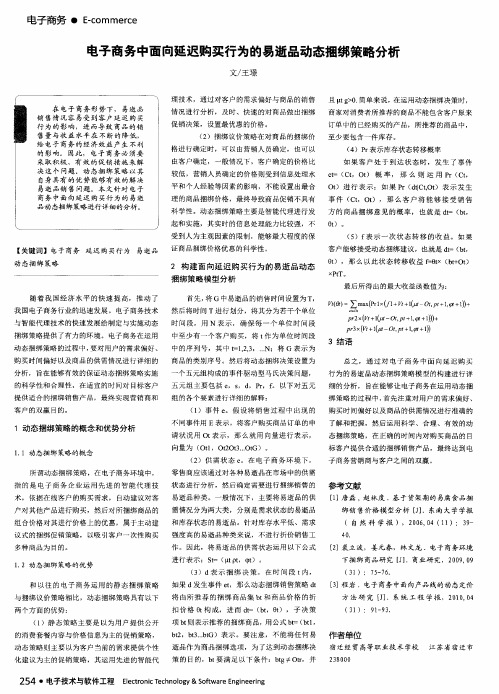
我国 电子商务行业的迅速发展 。电子商务技术 与智能代理技术的快速发展给制定与实施动态 捆绑策略提供 了有力的环境 。电子商务在运用 动态捆绑策略的过程 中, 要对用户的需求偏好、 购买时间偏好 以及商品的供需情况进行详细的 分析, 旨在能够有效的保证动态捆绑策略实施
的 科 学 性 和 合 理 性 ,在 适 宜 的 时 间 对 目标 客 户 提 供 适 合 的 捆 绑 销 售 产 品 ,最 终 实 现 营 销 商 和 客 户 的 双 赢 目的 。
动态捆 绑策略
( 5 )f 表 示 一次 状态 转移 的 收益。 如果
客 户 能 够 接 受 动 态捆 绑 建议 ,也就 是 d t =( b t , 0 t ), 那 么 以此 状 态 转 移 收 益 f = O t x( b t + O t )
x pt T。
易逝 品
证 商 品 捆 绑价 格 优 惠 的科 学 性 。
所 ( ) = ∑m a x ( p r 1 × 1 + + 1 ( 一 D f , p t + l , + 1 ) ) +
p r 2 x ( + 1 ( 一 O t , p t + 1 , + 1 ) ) ) + p r 3 x (  ̄+ 1 O 一 O t , p t + l , + 1 ) )
e t = _ -( C t ,Ot ) 概 率, 那 么 则 运 用 P r( C t , O t )进 行 表 示 ; 如 果 P r( d t l C t , o t ) 表 示 发 生
由客户确定,一般情况下,客户确定的价格 比 较低 ,营销人员确定 的价格则受到信息处理水 平和个人经验等因素的影响 ,不能设置 出最合 理的商品捆绑价格,最终导致商品促销不具有 科学性。动态捆绑策略主要是智能代理进行发
ddr retention原理
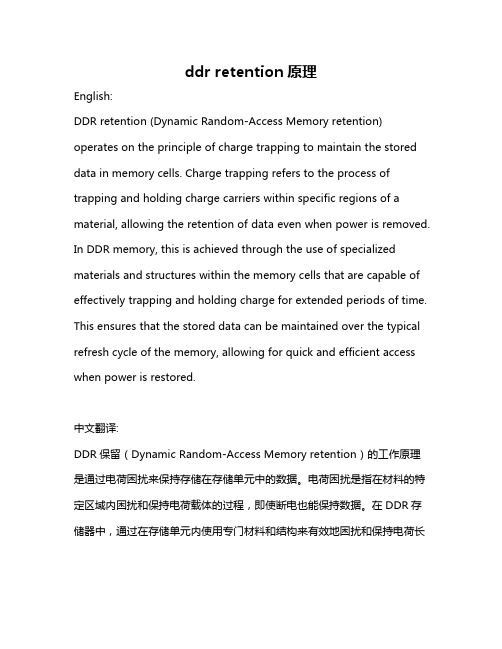
ddr retention原理English:DDR retention (Dynamic Random-Access Memory retention) operates on the principle of charge trapping to maintain the stored data in memory cells. Charge trapping refers to the process of trapping and holding charge carriers within specific regions of a material, allowing the retention of data even when power is removed. In DDR memory, this is achieved through the use of specialized materials and structures within the memory cells that are capable of effectively trapping and holding charge for extended periods of time. This ensures that the stored data can be maintained over the typical refresh cycle of the memory, allowing for quick and efficient access when power is restored.中文翻译:DDR保留(Dynamic Random-Access Memory retention)的工作原理是通过电荷困扰来保持存储在存储单元中的数据。
电荷困扰是指在材料的特定区域内困扰和保持电荷载体的过程,即使断电也能保持数据。
TAM和TRA整合模型下移动支付工具使用意愿研究
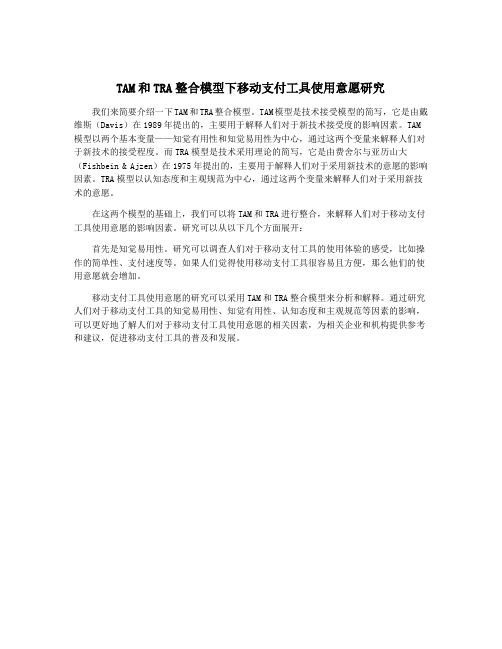
TAM和TRA整合模型下移动支付工具使用意愿研究
我们来简要介绍一下TAM和TRA整合模型。
TAM模型是技术接受模型的简写,它是由戴维斯(Davis)在1989年提出的,主要用于解释人们对于新技术接受度的影响因素。
TAM 模型以两个基本变量——知觉有用性和知觉易用性为中心,通过这两个变量来解释人们对于新技术的接受程度。
而TRA模型是技术采用理论的简写,它是由费舍尔与亚历山大(Fishbein & Ajzen)在1975年提出的,主要用于解释人们对于采用新技术的意愿的影响因素。
TRA模型以认知态度和主观规范为中心,通过这两个变量来解释人们对于采用新技术的意愿。
在这两个模型的基础上,我们可以将TAM和TRA进行整合,来解释人们对于移动支付工具使用意愿的影响因素。
研究可以从以下几个方面展开:
首先是知觉易用性。
研究可以调查人们对于移动支付工具的使用体验的感受,比如操作的简单性、支付速度等。
如果人们觉得使用移动支付工具很容易且方便,那么他们的使用意愿就会增加。
移动支付工具使用意愿的研究可以采用TAM和TRA整合模型来分析和解释。
通过研究人们对于移动支付工具的知觉易用性、知觉有用性、认知态度和主观规范等因素的影响,可以更好地了解人们对于移动支付工具使用意愿的相关因素,为相关企业和机构提供参考和建议,促进移动支付工具的普及和发展。
《2024年融合因果注意力Transformer模型的股价预测研究》范文

《融合因果注意力Transformer模型的股价预测研究》篇一一、引言股价预测是金融市场分析和投资决策的关键环节,随着人工智能技术的飞速发展,利用深度学习模型进行股价预测成为了研究热点。
传统的股价预测方法大多依赖于线性回归、时间序列分析等统计方法,但这些方法往往无法充分捕捉股票市场中的非线性、复杂依赖关系。
近年来,注意力机制和Transformer模型在自然语言处理等领域取得了显著成果,将其应用于股价预测领域也引起了广泛关注。
本文提出了一种融合因果注意力的Transformer 模型,以更好地捕捉股价序列的时序依赖性和因果关系,提高股价预测的准确性。
二、相关文献综述在股价预测领域,已有众多研究利用不同的人工智能模型进行探索。
其中,循环神经网络(RNN)及其变体如长短期记忆网络(LSTM)和门控循环单元(GRU)被广泛应用于时间序列预测。
然而,这些模型在捕捉长期依赖关系时存在局限性。
Transformer模型因其自注意力机制在许多任务上取得了卓越的成果,近年来也被引入到股价预测中。
但现有研究鲜少考虑股价预测中的因果关系。
因此,本研究旨在融合因果注意力与Transformer模型,以提高股价预测的精度。
三、融合因果注意力Transformer模型本研究提出的模型融合了因果注意力和Transformer模型,通过自注意力和因果注意力共同作用,更好地捕捉股价序列的时序依赖性和因果关系。
模型结构包括编码器、解码器以及嵌入层等部分。
编码器利用Transformer的自注意力机制捕捉输入序列的内部关系,而因果注意力则确保模型在生成预测时考虑到了时间上的先后顺序和因果关系。
四、实证研究本研究选取了某股票市场的历史股价数据作为实验数据集,通过融合因果注意力的Transformer模型进行训练和预测。
在实验过程中,我们对比了传统统计方法、LSTM、GRU以及未融合因果注意力的Transformer模型,以验证本模型的优越性。
云计算HCIP考试题与参考答案
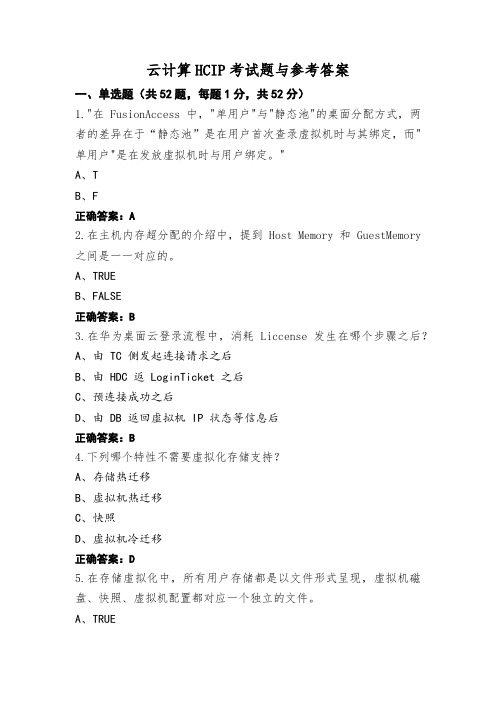
云计算HCIP考试题与参考答案一、单选题(共52题,每题1分,共52分)1."在 FusionAccess 中,"单用户"与"静态池"的桌面分配方式,两者的差异在于“静态池”是在用户首次查录虚拟机时与其绑定,而"单用户"是在发放虚拟机时与用户绑定。
"A、TB、F正确答案:A2.在主机内存超分配的介绍中,提到 Host Memory 和 GuestMemory 之间是一一对应的。
A、TRUEB、FALSE正确答案:B3.在华为桌面云登录流程中,消耗 Liccense 发生在哪个步骤之后?A、由 TC 侧发起连接请求之后B、由 HDC 返 LoginTicket 之后C、预连接成功之后D、由 DB 返回虚拟机 IP 状态等信息后正确答案:B4.下列哪个特性不需要虚拟化存储支持?A、存储热迁移B、虚拟机热迁移C、快照D、虚拟机冷迁移正确答案:D5.在存储虚拟化中,所有用户存储都是以文件形式呈现,虚拟机磁盘、快照、虚拟机配置都对应一个独立的文件。
A、TRUEB、FALSE正确答案:B6.以下对于桌面组类型的描述,正确的是?A、动态池:“虚拟机组类型”为“完整复制”,桌面组中用户与虚拟机没有固定的分配绑定关系,但一个用户只能一次使用其中一台虚拟机B、专有:"虚拟机组类型"可以为"完整复制",也可以为"链接克隆”C、静态池:"虚拟机组类型"为"链接克隆",桌面组在用户首次登录时,会随机分配给用户一台虚拟机与用户绑定,且一个用户只能绑定一台虚拟机D、专有类型的桌面组类型包括"动态多用户"和"单用户"正确答案:C7.FusionCompute 分布式虚拟交换机一方面可以对多台服务器的虚拟交换机统配置、管理和监控。
diffusion policy—基于扩散模型的机器人动作生成策略

diffusion policy—基于扩散模型的机器人动作生成策
略
Diffusion Policy是基于扩散模型的机器人动作生成策略,其主要目标是学习一个概率模型,将无噪声的原始动作逐步向有噪声的动作进行转换。
通过训练,该策略能够学习到一个最佳的噪声水平,使得机器人能够更好地适应复杂的环境并执行任务。
相比于传统的基于强化学习的策略,Diffusion Policy在解决高维度、连续动作空间的问题上更具优势。
基于扩散模型的机器人动作生成策略主要包括以下步骤:
1. 初始化:设置一个随机的初始状态,并选择一个随机的初始动作。
2. 重复采样:重复以下步骤直到满足终止条件:
a. 根据当前状态和策略生成一个动作。
b. 将该动作应用到环境中,并获取新的状态和奖励。
c. 根据新的状态和奖励更新策略。
3. 终止:输出最终的策略和奖励。
基于扩散模型的机器人动作生成策略的优势在于:
1. 能够处理高维度的连续动作空间,使得机器人能够更好地适应复杂的环境和任务。
2. 通过逐步引入噪声,使得机器人能够逐步探索未知的状态和动作,从而更好地适应环境。
3. 可以与深度学习技术相结合,利用深度神经网络来表示策略,提高策略的表示能力和泛化能力。
基于扩散模型的机器人动作生成策略的应用场景包括但不限于:智能家居、医疗服务、工业自动化、农业自动化等领域。
该策略具有广泛的应用前景,将会成为未来机器人领域的一个重要研究方向和发展趋势。
随机置换算法的基本原理 -回复
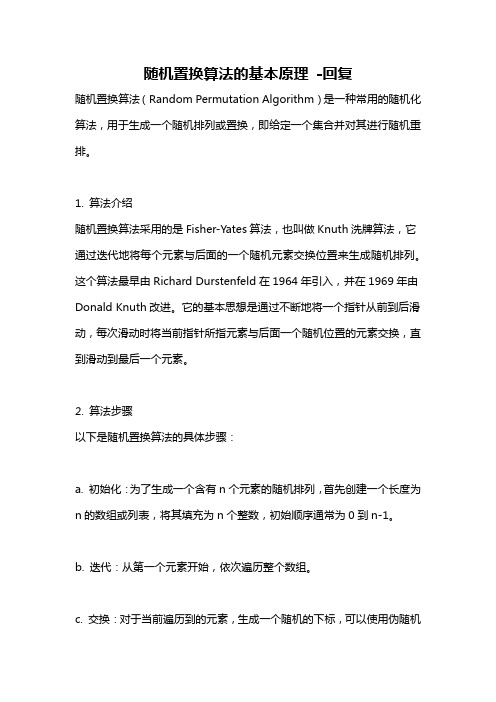
随机置换算法的基本原理-回复随机置换算法(Random Permutation Algorithm)是一种常用的随机化算法,用于生成一个随机排列或置换,即给定一个集合并对其进行随机重排。
1. 算法介绍随机置换算法采用的是Fisher-Yates算法,也叫做Knuth洗牌算法,它通过迭代地将每个元素与后面的一个随机元素交换位置来生成随机排列。
这个算法最早由Richard Durstenfeld在1964年引入,并在1969年由Donald Knuth改进。
它的基本思想是通过不断地将一个指针从前到后滑动,每次滑动时将当前指针所指元素与后面一个随机位置的元素交换,直到滑动到最后一个元素。
2. 算法步骤以下是随机置换算法的具体步骤:a. 初始化:为了生成一个含有n个元素的随机排列,首先创建一个长度为n的数组或列表,将其填充为n个整数,初始顺序通常为0到n-1。
b. 迭代:从第一个元素开始,依次遍历整个数组。
c. 交换:对于当前遍历到的元素,生成一个随机的下标,可以使用伪随机数生成器来获取一个介于当前位置和数组末尾之间的随机整数。
然后将当前元素与随机下标位置的元素进行交换。
d. 下一个:指针移动到下一个位置,即指向当前元素的下一个元素。
e. 重复:重复步骤c和d,直到指针指向最后一个元素。
3. 算法性质随机置换算法具有以下性质:a. 均匀性:通过随机选择的方式,每个元素都有相等的机会被置换到任意位置,从而实现等概率的随机排列。
b. 唯一性:每次生成的随机排列是唯一的,且不会存在重复的排列。
c. 时间复杂度:该算法的时间复杂度为O(n),其中n为元素的个数。
d. 空间复杂度:该算法的空间复杂度为O(n),需要额外的数组或列表来存储元素。
4. 应用场景随机置换算法可以应用于各种需要随机排列的场景,例如:a. 洗牌算法:在扑克牌游戏中,需要随机洗牌以确保每一次发牌都是随机的。
b. 随机采样:在进行实验或统计学抽样时,需要从一个样本集合中随机抽取一组样本。
kafka背压机制
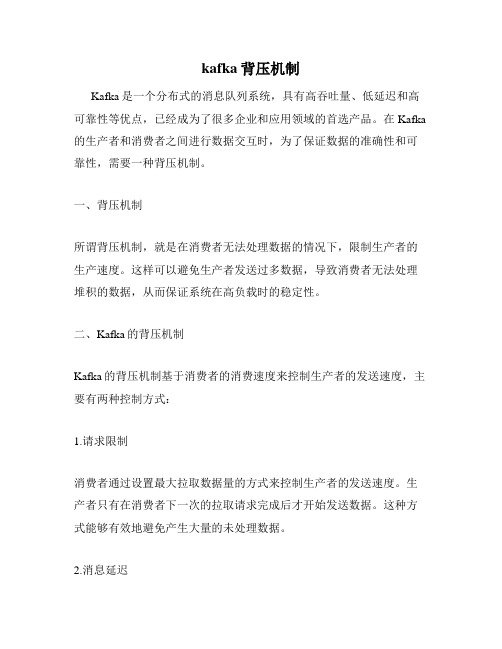
kafka背压机制
Kafka是一个分布式的消息队列系统,具有高吞吐量、低延迟和高可靠性等优点,已经成为了很多企业和应用领域的首选产品。
在Kafka 的生产者和消费者之间进行数据交互时,为了保证数据的准确性和可靠性,需要一种背压机制。
一、背压机制
所谓背压机制,就是在消费者无法处理数据的情况下,限制生产者的生产速度。
这样可以避免生产者发送过多数据,导致消费者无法处理堆积的数据,从而保证系统在高负载时的稳定性。
二、Kafka的背压机制
Kafka的背压机制基于消费者的消费速度来控制生产者的发送速度,主要有两种控制方式:
1.请求限制
消费者通过设置最大拉取数据量的方式来控制生产者的发送速度。
生产者只有在消费者下一次的拉取请求完成后才开始发送数据。
这种方式能够有效地避免产生大量的未处理数据。
2.消息延迟
当消费者无法及时处理大量数据时,可以采用消息延迟的方式来保证系统的稳定性。
在这种情况下,Kafka会将数据暂时存储在缓存区中,并且等待一段时间后再进行发送。
这种方式虽然会导致一些延迟,但可以有效地减轻系统的压力。
三、总结
Kafka的背压机制为消费者和生产者之间的数据交互提供了强有力的保障,能够保证系统在高负载时的稳定性和可靠性。
通过对Kafka的背压机制的深入了解,可以更好地了解Kafka的工作原理,提高系统的性能和稳定性,为企业和应用领域的发展做出更大的贡献。
tbquant快速回测原理
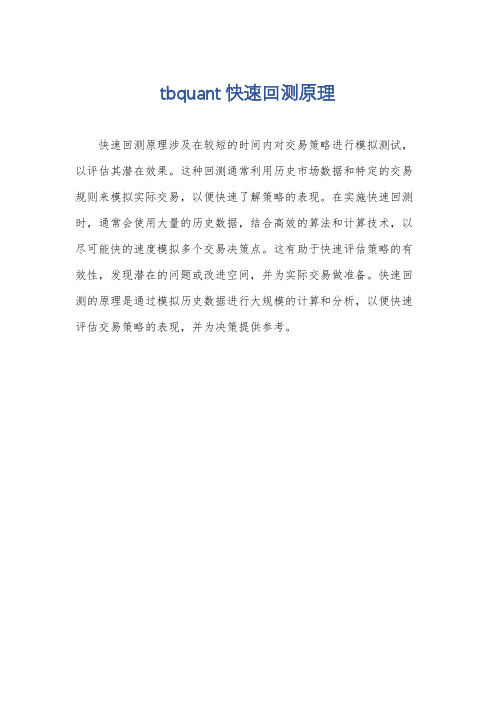
tbquant快速回测原理
快速回测原理涉及在较短的时间内对交易策略进行模拟测试,以评估其潜在效果。
这种回测通常利用历史市场数据和特定的交易规则来模拟实际交易,以便快速了解策略的表现。
在实施快速回测时,通常会使用大量的历史数据,结合高效的算法和计算技术,以尽可能快的速度模拟多个交易决策点。
这有助于快速评估策略的有效性,发现潜在的问题或改进空间,并为实际交易做准备。
快速回测的原理是通过模拟历史数据进行大规模的计算和分析,以便快速评估交易策略的表现,并为决策提供参考。
策动点函数和转移函数 -回复
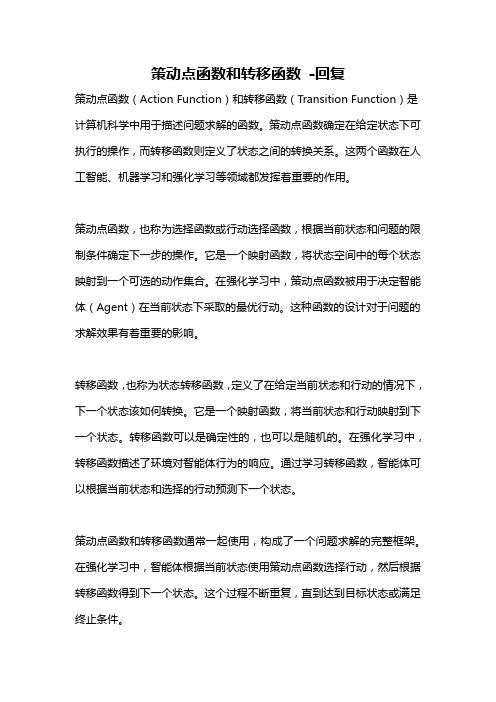
策动点函数和转移函数-回复策动点函数(Action Function)和转移函数(Transition Function)是计算机科学中用于描述问题求解的函数。
策动点函数确定在给定状态下可执行的操作,而转移函数则定义了状态之间的转换关系。
这两个函数在人工智能、机器学习和强化学习等领域都发挥着重要的作用。
策动点函数,也称为选择函数或行动选择函数,根据当前状态和问题的限制条件确定下一步的操作。
它是一个映射函数,将状态空间中的每个状态映射到一个可选的动作集合。
在强化学习中,策动点函数被用于决定智能体(Agent)在当前状态下采取的最优行动。
这种函数的设计对于问题的求解效果有着重要的影响。
转移函数,也称为状态转移函数,定义了在给定当前状态和行动的情况下,下一个状态该如何转换。
它是一个映射函数,将当前状态和行动映射到下一个状态。
转移函数可以是确定性的,也可以是随机的。
在强化学习中,转移函数描述了环境对智能体行为的响应。
通过学习转移函数,智能体可以根据当前状态和选择的行动预测下一个状态。
策动点函数和转移函数通常一起使用,构成了一个问题求解的完整框架。
在强化学习中,智能体根据当前状态使用策动点函数选择行动,然后根据转移函数得到下一个状态。
这个过程不断重复,直到达到目标状态或满足终止条件。
在构建策动点函数时,需要考虑当前状态的特征,问题的限制条件以及预期的最优行动。
通常情况下,策动点函数可以通过模型拟合、规则定义或者启发式搜索等方法来构建。
选择一个合适的策动点函数可以提高问题求解的效率和准确性。
转移函数的设计也是一个关键的问题。
转移函数不仅需要考虑当前状态和行动,还需要考虑环境的特性和约束条件。
在实际问题中,转移函数可能是复杂的,需要使用统计方法、模型拟合或者问题领域的专业知识来进行建模和估计。
策动点函数和转移函数在人工智能和机器学习领域有着广泛的应用。
在强化学习中,它们是智能体与环境交互的核心组成部分。
通过学习和优化策动点函数和转移函数,智能体可以在复杂的环境中高效地解决各种问题,从而实现智能化的决策和行为。
回调法收回相关调查问卷名词解释
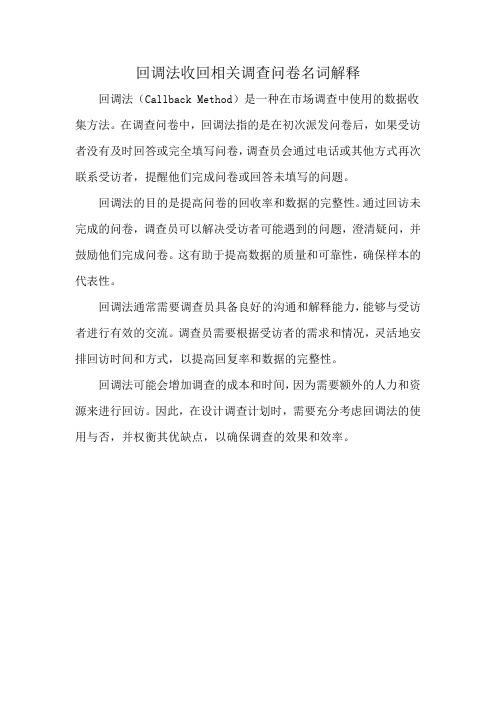
回调法收回相关调查问卷名词解释回调法(Callback Method)是一种在市场调查中使用的数据收集方法。
在调查问卷中,回调法指的是在初次派发问卷后,如果受访者没有及时回答或完全填写问卷,调查员会通过电话或其他方式再次联系受访者,提醒他们完成问卷或回答未填写的问题。
回调法的目的是提高问卷的回收率和数据的完整性。
通过回访未完成的问卷,调查员可以解决受访者可能遇到的问题,澄清疑问,并鼓励他们完成问卷。
这有助于提高数据的质量和可靠性,确保样本的代表性。
回调法通常需要调查员具备良好的沟通和解释能力,能够与受访者进行有效的交流。
调查员需要根据受访者的需求和情况,灵活地安排回访时间和方式,以提高回复率和数据的完整性。
回调法可能会增加调查的成本和时间,因为需要额外的人力和资源来进行回访。
因此,在设计调查计划时,需要充分考虑回调法的使用与否,并权衡其优缺点,以确保调查的效果和效率。
马尔科夫链状态转移策略优化探讨
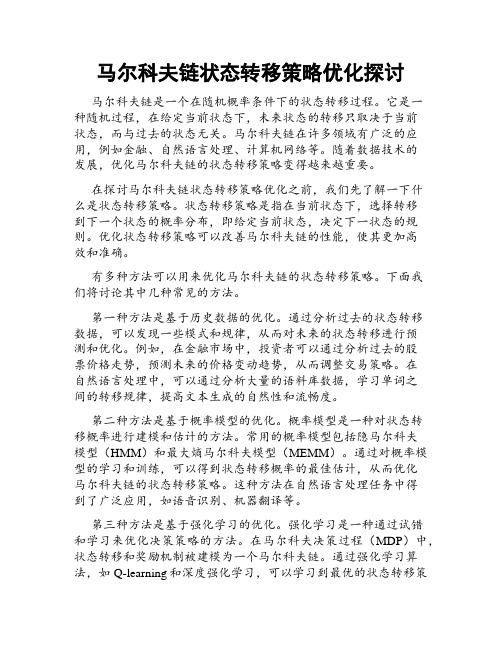
马尔科夫链状态转移策略优化探讨马尔科夫链是一个在随机概率条件下的状态转移过程。
它是一种随机过程,在给定当前状态下,未来状态的转移只取决于当前状态,而与过去的状态无关。
马尔科夫链在许多领域有广泛的应用,例如金融、自然语言处理、计算机网络等。
随着数据技术的发展,优化马尔科夫链的状态转移策略变得越来越重要。
在探讨马尔科夫链状态转移策略优化之前,我们先了解一下什么是状态转移策略。
状态转移策略是指在当前状态下,选择转移到下一个状态的概率分布,即给定当前状态,决定下一状态的规则。
优化状态转移策略可以改善马尔科夫链的性能,使其更加高效和准确。
有多种方法可以用来优化马尔科夫链的状态转移策略。
下面我们将讨论其中几种常见的方法。
第一种方法是基于历史数据的优化。
通过分析过去的状态转移数据,可以发现一些模式和规律,从而对未来的状态转移进行预测和优化。
例如,在金融市场中,投资者可以通过分析过去的股票价格走势,预测未来的价格变动趋势,从而调整交易策略。
在自然语言处理中,可以通过分析大量的语料库数据,学习单词之间的转移规律,提高文本生成的自然性和流畅度。
第二种方法是基于概率模型的优化。
概率模型是一种对状态转移概率进行建模和估计的方法。
常用的概率模型包括隐马尔科夫模型(HMM)和最大熵马尔科夫模型(MEMM)。
通过对概率模型的学习和训练,可以得到状态转移概率的最佳估计,从而优化马尔科夫链的状态转移策略。
这种方法在自然语言处理任务中得到了广泛应用,如语音识别、机器翻译等。
第三种方法是基于强化学习的优化。
强化学习是一种通过试错和学习来优化决策策略的方法。
在马尔科夫决策过程(MDP)中,状态转移和奖励机制被建模为一个马尔科夫链。
通过强化学习算法,如Q-learning和深度强化学习,可以学习到最优的状态转移策略。
这种方法在机器人控制、游戏玩法优化等领域有着广泛的应用。
除了以上几种方法,还有很多其他的优化方法可以应用于马尔科夫链的状态转移策略。
kafka重平衡机制
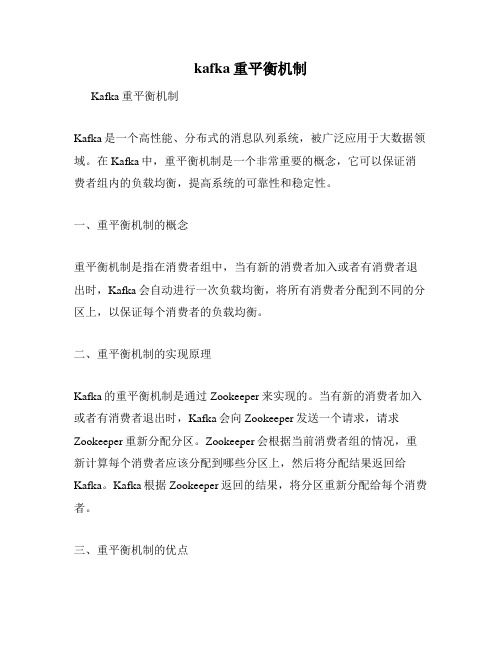
kafka重平衡机制Kafka重平衡机制Kafka是一个高性能、分布式的消息队列系统,被广泛应用于大数据领域。
在Kafka中,重平衡机制是一个非常重要的概念,它可以保证消费者组内的负载均衡,提高系统的可靠性和稳定性。
一、重平衡机制的概念重平衡机制是指在消费者组中,当有新的消费者加入或者有消费者退出时,Kafka会自动进行一次负载均衡,将所有消费者分配到不同的分区上,以保证每个消费者的负载均衡。
二、重平衡机制的实现原理Kafka的重平衡机制是通过Zookeeper来实现的。
当有新的消费者加入或者有消费者退出时,Kafka会向Zookeeper发送一个请求,请求Zookeeper重新分配分区。
Zookeeper会根据当前消费者组的情况,重新计算每个消费者应该分配到哪些分区上,然后将分配结果返回给Kafka。
Kafka根据Zookeeper返回的结果,将分区重新分配给每个消费者。
三、重平衡机制的优点重平衡机制可以保证消费者组内的负载均衡,避免出现某些消费者负载过重,而其他消费者负载过轻的情况。
这样可以提高系统的可靠性和稳定性,避免出现系统崩溃或者消息丢失的情况。
四、重平衡机制的注意事项在使用重平衡机制时,需要注意以下几点:1.消费者组中的消费者数量不宜过多,一般建议不超过10个。
2.消费者组中的消费者应该尽量保持稳定,避免频繁加入或退出。
3.消费者组中的消费者应该尽量保持相同的消费速度,避免出现某些消费者消费速度过快,而其他消费者消费速度过慢的情况。
4.在进行重平衡时,可能会出现消息重复消费的情况,需要在程序中进行处理。
五、总结重平衡机制是Kafka中非常重要的一个概念,它可以保证消费者组内的负载均衡,提高系统的可靠性和稳定性。
在使用重平衡机制时,需要注意消费者组中的消费者数量、稳定性和消费速度等因素,以避免出现消息重复消费的情况。
随机游走
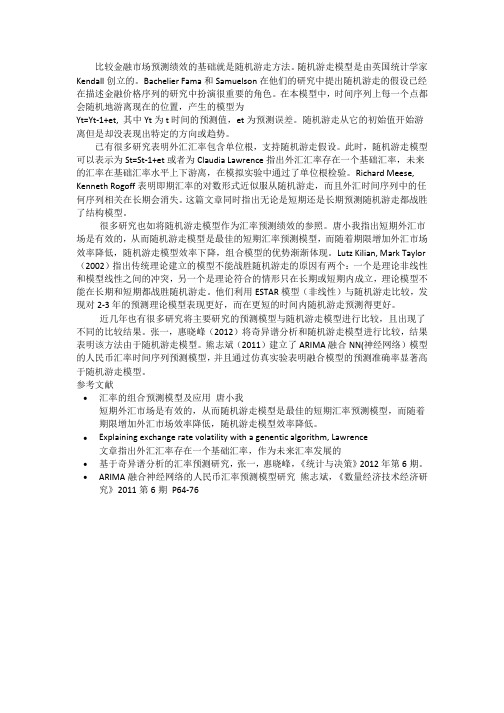
比较金融市场预测绩效的基础就是随机游走方法。
随机游走模型是由英国统计学家Kendall创立的。
Bachelier Fama和Samuelson在他们的研究中提出随机游走的假设已经在描述金融价格序列的研究中扮演很重要的角色。
在本模型中,时间序列上每一个点都会随机地游离现在的位置,产生的模型为Yt=Yt-1+et, 其中Yt为t时间的预测值,et为预测误差。
随机游走从它的初始值开始游离但是却没表现出特定的方向或趋势。
已有很多研究表明外汇汇率包含单位根,支持随机游走假设。
此时,随机游走模型可以表示为St=St-1+et或者为Claudia Lawrence指出外汇汇率存在一个基础汇率,未来的汇率在基础汇率水平上下游离,在模拟实验中通过了单位根检验。
Richard Meese, Kenneth Rogoff表明即期汇率的对数形式近似服从随机游走,而且外汇时间序列中的任何序列相关在长期会消失。
这篇文章同时指出无论是短期还是长期预测随机游走都战胜了结构模型。
很多研究也如将随机游走模型作为汇率预测绩效的参照。
唐小我指出短期外汇市场是有效的,从而随机游走模型是最佳的短期汇率预测模型,而随着期限增加外汇市场效率降低,随机游走模型效率下降,组合模型的优势渐渐体现。
Lutz Kilian, Mark Taylor (2002)指出传统理论建立的模型不能战胜随机游走的原因有两个:一个是理论非线性和模型线性之间的冲突,另一个是理论符合的情形只在长期或短期内成立,理论模型不能在长期和短期都战胜随机游走。
他们利用ESTAR模型(非线性)与随机游走比较,发现对2-3年的预测理论模型表现更好,而在更短的时间内随机游走预测得更好。
近几年也有很多研究将主要研究的预测模型与随机游走模型进行比较,且出现了不同的比较结果。
张一,惠晓峰(2012)将奇异谱分析和随机游走模型进行比较,结果表明该方法由于随机游走模型。
熊志斌(2011)建立了ARIMA融合NN(神经网络)模型的人民币汇率时间序列预测模型,并且通过仿真实验表明融合模型的预测准确率显著高于随机游走模型。
chatgpt 的工作原理
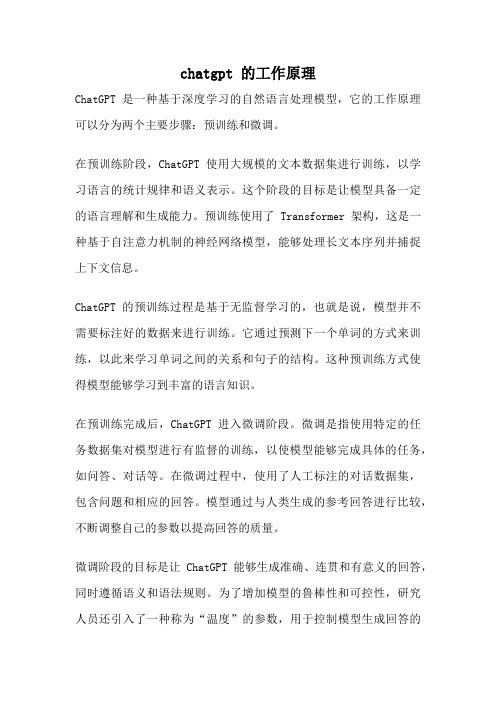
chatgpt 的工作原理ChatGPT是一种基于深度学习的自然语言处理模型,它的工作原理可以分为两个主要步骤:预训练和微调。
在预训练阶段,ChatGPT使用大规模的文本数据集进行训练,以学习语言的统计规律和语义表示。
这个阶段的目标是让模型具备一定的语言理解和生成能力。
预训练使用了Transformer架构,这是一种基于自注意力机制的神经网络模型,能够处理长文本序列并捕捉上下文信息。
ChatGPT的预训练过程是基于无监督学习的,也就是说,模型并不需要标注好的数据来进行训练。
它通过预测下一个单词的方式来训练,以此来学习单词之间的关系和句子的结构。
这种预训练方式使得模型能够学习到丰富的语言知识。
在预训练完成后,ChatGPT进入微调阶段。
微调是指使用特定的任务数据集对模型进行有监督的训练,以使模型能够完成具体的任务,如问答、对话等。
在微调过程中,使用了人工标注的对话数据集,包含问题和相应的回答。
模型通过与人类生成的参考回答进行比较,不断调整自己的参数以提高回答的质量。
微调阶段的目标是让ChatGPT能够生成准确、连贯和有意义的回答,同时遵循语义和语法规则。
为了增加模型的鲁棒性和可控性,研究人员还引入了一种称为“温度”的参数,用于控制模型生成回答的多样性程度。
ChatGPT的工作原理基于大规模的预训练和有监督的微调,这使得它能够在各种对话任务中表现出色。
然而,它也存在一些限制,比如在处理复杂问题时可能出现错误或生成不准确的回答。
此外,由于预训练数据的选择和微调数据集的限制,模型在某些领域或特定主题上的表现可能相对较差。
总的来说,ChatGPT是一种强大的自然语言处理模型,它通过预训练和微调的方式,能够生成具有语义理解和生成能力的自然语言回答。
它的工作原理基于深度学习和自注意力机制,通过大规模的数据训练和有监督的微调,使得模型能够在对话任务中取得优秀的表现。
然而,我们也需要意识到模型的局限性,并在使用时谨慎对待其生成的回答。
反向随机失活详解
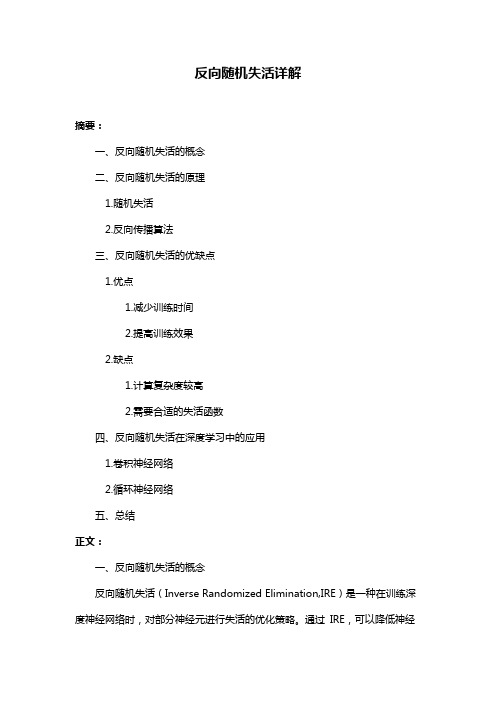
反向随机失活详解摘要:一、反向随机失活的概念二、反向随机失活的原理1.随机失活2.反向传播算法三、反向随机失活的优缺点1.优点1.减少训练时间2.提高训练效果2.缺点1.计算复杂度较高2.需要合适的失活函数四、反向随机失活在深度学习中的应用1.卷积神经网络2.循环神经网络五、总结正文:一、反向随机失活的概念反向随机失活(Inverse Randomized Elimination,IRE)是一种在训练深度神经网络时,对部分神经元进行失活的优化策略。
通过IRE,可以降低神经网络的训练时间,提高训练效果。
二、反向随机失活的原理1.随机失活随机失活(Randomized Elimination,RE)是一种在训练过程中随机丢弃部分神经元的策略。
这种方法可以降低神经网络的复杂度,从而减少训练时间。
然而,随机失活可能导致训练效果降低,因此需要配合其他优化方法使用。
2.反向传播算法反向传播(Backpropagation,BP)算法是深度学习中常用的优化方法,通过计算损失函数的梯度,指导神经元参数的更新。
在IRE 中,反向传播算法仍然用于计算梯度,但会受到随机失活策略的影响。
三、反向随机失活的优缺点1.优点(1)减少训练时间:通过随机失活部分神经元,可以降低神经网络的计算复杂度,从而减少训练时间。
(2)提高训练效果:IRE 可以在一定程度上避免梯度消失和梯度爆炸问题,提高训练效果。
2.缺点(1)计算复杂度较高:IRE 需要计算随机失活策略下,每个神经元的梯度,计算复杂度较高。
(2)需要合适的失活函数:为了保证IRE 的有效性,需要选择合适的失活函数,以平衡训练时间和训练效果。
四、反向随机失活在深度学习中的应用1.卷积神经网络在卷积神经网络(CNN)中,IRE 可以通过随机失活部分卷积核,降低计算复杂度,从而提高训练速度。
同时,IRE 有助于缓解梯度消失和梯度爆炸问题,提高模型性能。
2.循环神经网络在循环神经网络(RNN)中,IRE 可以通过随机失活部分循环单元,减少训练时间,同时提高训练效果。
- 1、下载文档前请自行甄别文档内容的完整性,平台不提供额外的编辑、内容补充、找答案等附加服务。
- 2、"仅部分预览"的文档,不可在线预览部分如存在完整性等问题,可反馈申请退款(可完整预览的文档不适用该条件!)。
- 3、如文档侵犯您的权益,请联系客服反馈,我们会尽快为您处理(人工客服工作时间:9:00-18:30)。
Retroactive Ordering for Dynamic Backtracking Roie Zivan,Uri Shapen,Moshe Zazone and Amnon Meisels,{zivanr,moshezaz,shapenko,am}@cs.bgu.ac.ilDepartment of Computer Science,Ben-Gurion University of the Negev,Beer-Sheva,84-105,IsraelAbstract.Dynamic Backtracking(DBT)is a well known algorithm for solvingConstraint Satisfaction Problems.In DBT,variables are allowed to keep theirassignment during backjump,if they are compatible with the set of eliminatingexplanations.A previous study has shown that when DBT is combined withvariable ordering heuristics it performs poorly compared to standard Conflict-directed Backjumping(CBJ)[1].The special feature of DBT,keeping validelimination explanations during backtracking,can be used for generating a newclass of ordering heuristics.In the proposed algorithm,the order of already as-signed variables can be changed.Consequently,the new class of algorithms istermed Retroactive DBT.In the proposed algorithm,the newly assigned variable can be moved to a positionin front of assigned variables with larger domains and as a result prune the searchspace more effectively.The experimental results presented in this paper show anadvantage of the new class of heuristics and algorithms over standard DBT andover CBJ.All algorithms tested were combined with forward-checking and useda Min-Domain heuristic.1IntroductionConflict directed Backjumping(CBJ)is a technique which is known to improve the search of Constraint Satisfaction Problems(CSP s)by a large factor[4,7].Its efficiency increases when it is combined with forward checking[8].The advantage of CBJ over standard backtracking algorithms lies in the use of conflict sets in order to prune un-solvable sub search spaces[8].The down side of CBJ is that when such a backtrack (back-jump)is performed,assignments of variables which were assigned later than the culprit assignment are discarded.Dynamic Backtracking(DBT)[5]improves on standard CBJ by preserving as-signments of non conflicting variables during back-jumps.In the original form of DBT, the culprit variable which replaces its assignment is moved to be the last among the assigned variables.In other words,the new assignment of the culprit variable must be consistent with all former assignments.Although DBT saves unnecessary assign-ment attempts and therefore was proposed as an improvement to CBJ,a later study by Baker[1]has revealed a major drawback of DBT.According to Baker,when no specific ordering heuristic is used,DBT performs better than CBJ.However,when ordering heuristics which are known to improve the run-time of CSP search algo-rithms by a large factor are used[6,2,3],DBT is slower than CBJ.This phenomenon is easy to explain.Whenever the algorithm performs a back-jump it actually takes a variable which was placed according to the heuristic in a high position and moves it to a lower position.Thus,while in CBJ,the variables are ordered according to the specific heuristic,in DBT the order of variables becomes dependent on the algorithm’s behavior[1].In order to leave the assignments of non conflicting variables without a change on backjumps,DBT maintains a system of eliminating explanations(Nogoods)[5]. As a result,the DBT algorithm maintains dynamic domains for all variables and can potentially benefit from the Min-Domain(failfirst)heuristic.The present paper investigates a number of improvements to DBT that use radical versions of the Min-Domain heuristic.First,the algorithm avoids moving the culprit variable to the lowest position in the partial assignment.This alone can be enough to eliminate the phenomenon reported by Baker[1].Second,the assigned variables which were originally ordered in a lower position than the culprit variable can be reordered according to their current domain size.Third,a retroactive ordering heuristic in which assigned variables are reordered is proposed.A retroactive heuristic allows an assigned variable to be moved upwards beyond assigned variables as far as the heuristic is justified.If for example the variables are ordered according to the Min-Domain heuristic,the potential of each currently assigned variable to have a small domain is fully utilized. We note that although variables are chosen according to a Min-Domain heuristic,a newly assigned variable can have a smaller current domain than previously assigned variables.This can happen because of two reasons.First,as a result of forward-checking which might cause values from the current variables’domain to be eliminated due to conflicts with unassigned variables.Second,as a result of multiple backtracks to the same variable which eliminate at least one value each time.Therefore,the exploitation of the heuristic properties can be done,not only by choosing the next variable to be assigned,but by placing it in its right place among the assigned variables after it is assigned successfully.The combination of the three ideas above was found to be successful in the empirical study presented in the present paper.2Retroactive Dynamic BacktrackingWe assume in our presentation that the reader is familiar with both DBT following[1] and CBJ[8].Thefirst step in enhancing the desired heuristic(Min-Domain in our case)for DBT is to avoid the moving forward variables that the algorithm backtracks to(i.e.culprit variables).One way to do this is to try to replace the assignment of the culprit variable and leave the variable in the same position.The second step is to reorder the assigned variables that have a lower order than the culprit assignment which was replaced.This step takes into consideration the possibility that the replaced assignment of a variable that lies higher in the order has the potential to change the size of the current domains of the already assigned variables that are ordered after it.The simplest way to perform this step is to reassign these variables and order them using the desired heuristic.The third step derives from the observation that in many cases the size of the current domain of a newly assigned variable is smaller than the current domains of variables which were assigned before it.Allowing a reordering of assigned variables enables the use of heuristic information which was not available while the previous assignments have been performed.This takes ordering heuristics to a new level and generates a radical new approach.Variables can be moved up in the order,in front of assigned variables of the partial solution. As long as the new assignment is placed after the most recent assignment which is in conflict with one of the variable’s values,the size of the domain of the assigned variable is not changed.Retroactive FC DBT1.var list←variables;2.assigned list←φ;3.pos←1;4.while(pos<N)5.next var←select next var(var list);6.var list.remove(next var);7.assign(next var);8.report solution;procedure assign(var)10.for each(value∈var.current domain)11.var.assignment←value;12.consistent←true;13.forall(i∈var list)and while consistent14.consistent←check forward(var,i);15.if not(consistent)16.nogood←resolve nogoods(i);17.store(var,nogood);18.undo reductions(var,pos);19.else20.nogood←resolve nogoods(pos);stVar←nogood.RHS variable;21.newPos←select new pos(var,lastVar);22.assigned list.insert(var,newPos);23.forall(var1∈assigned list)and(pos var1>newPos)24.check forward(var,var1);25.update nogoods(var,var1);26.forall(var2∈var list)27.update nogoods(var,var2);28.pos←pos+1;29.return;30.var.assignment←Nil;31.backtrack(var);procedure backtrack(var)32.nogood←resolve nogoods(var);33.if(nogood=φ)34.report no solution;35.stop;36.culprit←nogood.RHS variable;37.store(culprit,nogood);38.culprit.assignment←Nil;39.undo reductions(culprit,pos culprit);40.forall(var1∈assigned list)and(pos var1>newPos)41.undo reductions(var1,pos var1);42.var1.assignment←Nil;43.var list.insert(var1);44.assigned list.remove(var1);45.pos←pos culprit;procedure update nogoods(var1,var2)46.for each(val∈{var2.domain-var2.current domain})47.if not(check(var2,val,var1.assignment))48.nogood←remove eliminating nogood(var1,val);49.if not(∃var3∈nogood andpos var3<pos var1)50.nogood← var1.assignment→var2=val ;51.store(var2,nogood);Fig.1.The Retroactive FC DBT algorithmIn the best ordering heuristic proposed by the present paper,the new position of the assigned variable in the order of the partial solution is dependent on the size of its current domain.The heuristic checks all assignments from the last up to thefirst assignment which is included in the union of the newly assigned variable’s eliminating Nogoods.The new assignment will be placed right after thefirst assigned variable with a smaller current domain.Figures1presents the code of Retroactive Forward Checking Dynamic Backtrack-ing(Retro F C DBT).For lack of space we leave out the detailed description of the algorithm and its correctness proof.3Experimental EvaluationThe common approach in evaluating the performance of CSP algorithms is to mea-sure time in logical steps to eliminate implementation and technical parameters from affecting the results.The number of constraints checks serves as the measure in our experiments[9,7].(a)(b)s performed by DBT,CBJ and Retroactive DBT(a)p1=0.3,(b)p1=0.7.(a)(b)s performed by FC DBT,FC CBJ and FC Retroactive DBT(a)p1=0.3,(b)p1=0.7.Experiments were conducted on random CSPs of n variables,k values in each do-main,a constraints density of p1and tightness p2(which are commonly used in exper-imental evaluations of CSP algorithms[10]).Two sets of experiments were performed. In thefirst set the CSPs included15variables(n=15)and in the second set the CSPs included20variables(n=20).In all of our experiments the number of values for each variable was10(k=10).Two values of constraints density were used,p1=0.3and p1=0.7.The tightness value p2,was varied between0.1and0.9,in order to cover all ranges of problem difficulty.For each of the pairs offixed density and tightness(p1,p2), 50different random problems were solved by each algorithm and the results presented are an average of these50runs.Three algorithms were compared,Conflict Based Backjumping(CBJ),Dynamic Backtracking(DBT)and Retroactive Dynamic Backtracking(Retro DBT).In all of our experiments all the algorithms use a Min-Domain heuristic for choosing the next variable to be assigned.In thefirst set of experiments,the three algorithms were imple-mented without forward-checking.Figure2(a)presents the number of constraints checks performed by the three al-gorithms on low density CSPs(p1=0.3).The CBJ algorithm does not benefit from the heuristic when it is not combined with forward-checking.The advantage of both versions of DBT over CBJ is therefore large.Retroactive DBT improves on standard DBT by a large factor as well.Figure2(b)present the results for high density CSPs (p1=0.7).Although the results are similar,the differences between the algorithms are smaller for the case of higher density CSPs..In our second set of experiments,each algorithm was combined with Forward-Checking[8].This improvement enabled testing the algorithms on larger CSPs with 20variablesFigure3(a)presents the number of constraints checks performed by each of the algorithms.It is very clear that the combination of CBJ with forward-checking im-proves the algorithm and makes it compatible with the others.This is easy to explain since the pruned domains as a result of forward-checking enable an effective use of the Min-Domain heuristic.Both FC CBJ and Retroactive FC DBT outperform FC DBT. Retroactive FC DBT performs better than FC CBJ.Figures3(b)presents similar re-sults for higher density CSPs.As before,the differences between the algorithms are smaller when solving CSPs with higher densities.4DiscussionVariable ordering heuristics such as Min-Domain are known to improve the perfor-mance of CSP algorithms[6,2,3].This improvement results from a reduction in the search space explored by the algorithm.Previous studies have shown that DBT does not preserve the properties of variable ordering heuristics and as a result performs poorly compared to CBJ[1].The Retroactive DBT algorithm,presented in this paper, combines the advantages of both previous algorithms by preventing the placing of vari-ables in a position which does not support the heuristic and allowing the reordering(or reassigning)of assigned variables with lower priority than the culprit assignment after a backtrack operation.We have used the mechanism of Dynamic Backtracking which by maintaining elim-inating Nogoods,allows variables with higher priority to be reassigned while lower pri-ority variables keep their assignment.These dynamically maintained domains enable to take the Min-Domain heuristic to a new level.Standard backtracking algorithms use ordering heuristics only to decide on which variable is to be assigned next.Retroactive DBT enables the use of heuristics which reorder assigned variables.Since the sizes of the current domains of variables are dynamic during search,theflexibility of the heuristics which are possible in Retroactive DBT enables a dynamic enforcement of the Min-Domain property over assigned and unassigned variables.The ordering of assigned variables requires some overhead in computation when the algorithm maintains consistency by using Forward Checking.This overhead was found by the experiments presented in this paper to be worth the effort since the overall computation effort is reduced.References[1]Andrew B.Baker.The hazards of fancy backtracking.In Proceedings of the12th NationalConference on Artificial Intelligence(AAAI’94),Volume1,pages288–293,Seattle,WA, USA,July31-August41994.AAAI Press.[2] C.Bessiere and ing bidirectionality to speed up arc-consistency processing.Constraint Processing(LNCS923),pages157–169,1995.[3]R.Dechter and D.Frost.Backjump-based backtracking for constraint satisfaction problems.Artificial Intelligence,136:2:147–188,April2002.[4]Rina Dechter.Constraint Processing.Morgan Kaufman,2003.[5]M.L.Ginsberg.Dynamic backtracking.J.of Artificial Intelligence Research,1:25–46,1993.[6]R.M.Haralick and G.L.Elliott.Increasing tree search efficiency for constraint satisfactionproblems.Artificial Intelligence,14:263–313,1980.[7]G.Kondrak and P.van Beek.A theoretical evaluation of selected backtracking algorithms.Artificial Intelligence,21:365–387,1997.[8]P.Prosser.Hybrid algorithms for the constraint satisfaction putational Intel-ligence,9:268–299,1993.[9]P.Prosser.An empirical study of phase transitions in binary constraint satisfaction prob-lems.Artificial Intelligence,81:81–109,1996.[10] B.M.Smith.Locating the phase transition in binary constraint satisfaction problems.Arti-ficial Intelligence,81:155–181,1996.。
